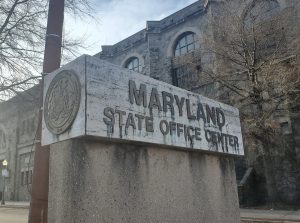
More than a year after former Gov. Larry Hogan agreed to transfer Maryland’s 28-acre State Center tract over to Baltimore City, city planners have selected an urban designer to start preparing a master plan to guide redevelopment of the property.
Gensler, the firm that serves as master planner for the revitalization of Harborplace, also has been chosen to begin creating a plan for State Center, just south of Bolton Hill at Martin Luther King Jr. Boulevard and Eutaw Street.
Baltimore’s Board of Estimates was to approve a professional services agreement with Gensler Architecture Planning & Design P. A. to perform a “marketing and conceptual predevelopment study” for the State Center area. (Gensler is a global architecture, design, and planning firm with 6,000+ professionals networked across the Americas, Europe, China, Asia Pacific and the Middle East.)
The city planning department’s goal is to “create a vision for the State Center site guiding eventual redevelopment as a transit oriented development and anchor for this area of Baltimore.” The department is the client for Gensler’s study, which runs from Jan. 1 to June 30, and will cost $396,550. The funding request is a sign that city officials are moving ahead to jumpstart planning for the land formerly occupied by a dozen state agencies that are relocating to other parts of the city.
State Center is served by both the light rail and Metro subway lines operated by the state. It has roughly the same amount of land as the Harbor Point community between Harbor East and Fells Point. In 2005, Former Gov. Robert Ehrlich Jr. (R) selected a team led by Maryland’s Ekistics LLC to redevelop the State Center area as a $1.5 billion mixed-use community, and planning continued through the administration of former Gov. Martin O’Malley (D).
A coalition of nearby neighborhoods, led by Bolton Hill’s John Kyle, worked closely with the planners to ensure that the project blended with commercial and other needs supported by residents.
But Gov. Larry Hogan and others on the state’s Board of Public Works canceled the plan in 2016, ending more than 10 years of work. In April 2021, Hogan announced plans to allocate $50 million to relocate more than 3,000 office workers to Baltimore’s central business district.
The plan was seen as a way to move state office workers out of aging office buildings while filling vacancies in privately-owned buildings and boosting downtown’s economy. In all, more than 5,300 full time state employees are set to relocate to downtown Baltimore by April 2024.
The previous redevelopment plan called for demolition of most of the state-owned buildings, which dated from the 1960s and 1970s and would have needed extensive repairs and upgrades for continued use. One of the few state-owned buildings that was targeted for preservation and adaptive reuse under the private developer’s plan was the Fifth Regiment Armory, a structure that dates from 1901 and was envisioned as a potential location for a grocery store and other community uses.
According to city planners, the contract with Gensler is not for the creation of a shovel-ready plan that can be put out for construction bids but for a more general “predevelopment” plan that can be used to show the highest and best uses for the property given current conditions in the real estate market. In other words, nothing will happen quickly.
Such a plan, officials say, could indicate which buildings might be recycled; what new uses could be introduced; how streets might be realigned; and how development could be completed in phases, most likely by seeking proposals from the private sector. Actual redevelopment of the parcel, planners say, will require even more planning and likely will take place over the next five to 10 years or more.
–Adapted from former Bolton Hill resident Ed Gunt’s article in Baltimore Fishbowl
